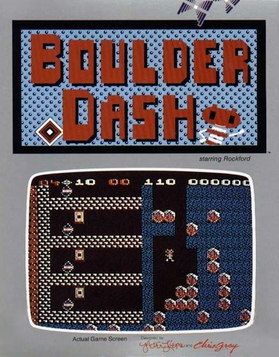
Boulder Dash is a maze-based puzzle video game released in 1984 by First Star Software for Atari 8-bit computers. It was created by Canadian developers Peter Liepa and Chris Gray. The player controls Rockford, who tunnels through dirt to collect diamonds. Boulders and other objects remain fixed until the dirt beneath them is removed, then they fall and become a hazard. Puzzles are designed around collecting diamonds without being crushed and exploiting the interactions between objects. The game's name is a pun on balderdash.

Road Runner is a racing video game based on the Wile E. Coyote and Road Runner shorts. It was released in arcades by Atari Games in 1985.
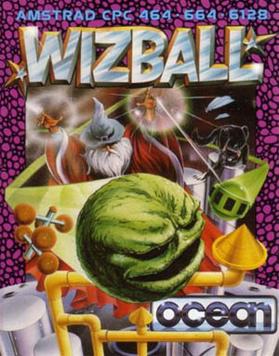
Wizball is a horizontally scrolling shooter written by Jon Hare and Chris Yates and released in 1987 for the Commodore 64 and later in the year for the ZX Spectrum and Amstrad CPC. Versions for the Amiga and Atari ST were released in the following year. Wizball was also ported to IBM PC compatibles and the Thomson MO5.

Mercenary is a 3D action-adventure game written for the Atari 8-bit computers and published by Novagen Software in 1985. It was converted to the Commodore 64, ZX Spectrum, Amstrad CPC, Atari ST, Amiga, and Commodore 16/116/Plus/4. The game uses vector graphics renderings of vast, sparse environments and has various methods of completing the game. It was also released as Mercenary: Escape from Targ and Mercenary: A Flight Simulator Adventure.

Barbarian: The Ultimate Warrior is a 1987 video game developed and published by Palace Software for the Amstrad CPC, Commodore 64, and ZX Spectrum. The game was ported to many other systems and was licensed to Epyx who published it as Death Sword in the United States.
CDS Software was an independent publisher and developer of computer game software based in Doncaster, South Yorkshire, UK.
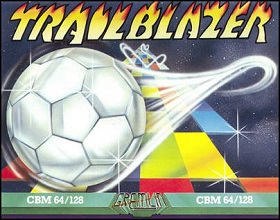
Trailblazer is a racing video game developed by Mr. Chip Software and published by Gremlin Graphics for the ZX Spectrum, Commodore 64, Atari 8-bit computers, Amstrad CPC, Commodore 16 and Plus/4 in 1986. It was ported to the Amiga and Atari ST.

Graphic Adventure Creator is a game creation system/programming language for adventure games published by Incentive Software, originally written on the Amstrad CPC by Sean Ellis, and then ported to other platforms by, amongst others, Brendan Kelly (Spectrum), Dave Kirby and "The Kid" (C64). The pictures in the demo adventure, Ransom, were made by Pete James and the box cover art by Pete Carter.

Beach Head II: The Dictator Strikes Back is 1985 shoot 'em up video game for the Commodore 64, a sequel to Beach Head, developed and published by Access Software. It was designed by Bruce Carver and his brother, Roger, and was released for the Amstrad CPC, Apple II, Atari 8-bit computers, Commodore 64, and ZX Spectrum.
Thorn EMI Computer Software was a British video games software house set up in the early 1980s as part of the now-defunct British conglomerate Thorn EMI. They released a number of games in the early 1980s, initially for the Atari 8-bit computers, and later for the ZX Spectrum, Commodore 64 and VIC-20 computers. In 1984, the Thorn EMI name was dropped in favour of Creative Sparks as the company were reportedly unhappy with their image in the video games market. A budget label, Sparklers, was created in early 1985 to publish titles at £2.50. Later in 1985, Creative Sparks, Sparklers and the distribution company, Creative Sparks Distribution (CSD) gained independence from Thorn EMI after a management buyout.
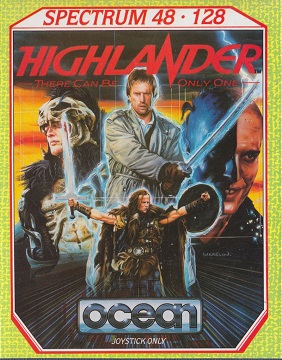
Highlander is a 1986 fighting game developed by Canvas and published by Ocean Software for the ZX Spectrum, Commodore 64, and Amstrad CPC home computers. It is based on the 1986 film of the same name. Highlander was panned by reviewers.

Colossus Chess is a series of chess-playing computer programs developed by Martin Bryant, commercially released for various home computers in the 1980s.

Brian Clough's Football Fortunes is a sports video game featuring English football player Brian Clough. It was released in 1987 for the Amiga, Amstrad CPC, Amstrad PCW, Atari 8-bit computers, Atari ST, BBC Micro, Commodore 16, Plus/4, Commodore 64, MS-DOS, Acorn Electron, MSX, and ZX Spectrum.
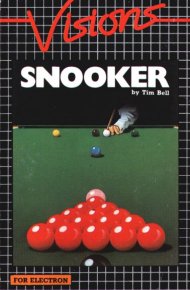
Snooker is a sports video game published by Visions Software Factory in 1983 and released for the Acorn Electron, BBC Micro, Commodore 64, VIC-20, and ZX Spectrum.

Spy vs. Spy II: The Island Caper is a 1985 video game developed by First Star Software. It is the sequel to Spy vs. Spy. It can be played as both single-player and multiplayer
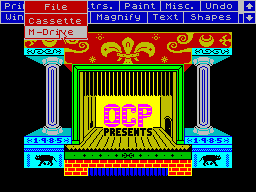
OCP Art Studio or Art Studio was a popular bitmap graphics editor for home computers released in 1985, created by Oxford Computer Publishing and written by James Hutchby.

Steve Davis World Snooker is a sports simulation video game developed by Binary Design and published by CDS Software. It simulates different types of cue sports, specifically snooker, pool and billiards. Released under licence from 6-time Snooker World Champion, Steve Davis, it is a sequel to their 1984 game Steve Davis Snooker.
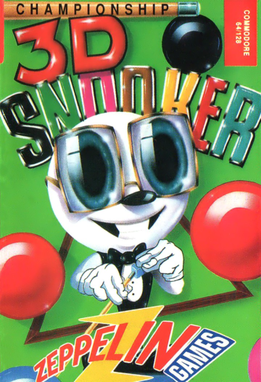
Championship 3D Snooker is a sports simulation video game developed and created by Steven Walters and published by Zeppelin Games Limited in 1992. Championship 3D Snooker simulates the cue sport snooker, and is an early pioneer of 3D computer graphics in snooker games, first used in Jimmy White's 'Whirlwind' Snooker, and would be adopted for most snooker games that followed, including the Virtual Pool series.

Classic Snooker is a sports simulation video game developed and published by Anco Software in 1987. Classic Snooker simulates the cue sport snooker, and was released for the Commodore 16 and Commodore 64.
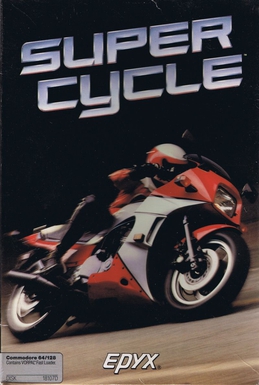
Super Cycle is a 1986 racing video game developed and published by Epyx. Originally released for the Commodore 64, Amstrad CPC, ZX Spectrum and Atari ST, it is a clone of Sega's 1985 arcade racing game Hang-On.



















